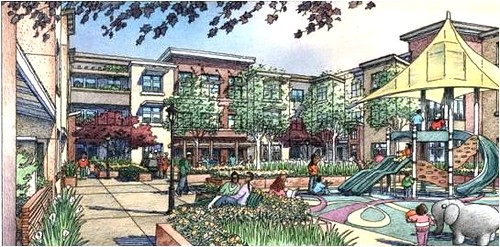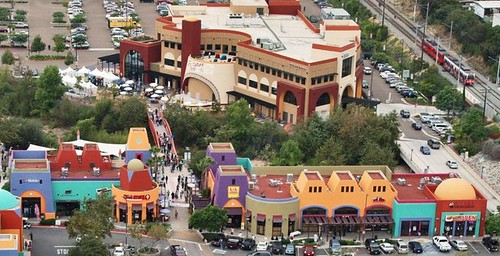Bank of America supports affordable green neighborhoods with grant program

Posted June 1, 2012 at 1:15PM
Last week, the Bank of America Charitable Foundation and the US Green Building Council announced the opening of the 2012 Affordable Green Neighborhoods Grant Program. Made possible by a $500,000 grant from the Foundation, the program will award $25,000 cash grants, as well as educational resources, to developers of affordable housing who are committed to building sustainable communities through the LEED for Neighborhood Development green rating system. The Green Building Council, which administers LEED-ND, will accept applications from now until Aug. 10, 2012.
LEED-ND and affordable revitalization
As many readers know, LEED-ND encourages the building of (or the building of significant contributions to) sustainable neighborhoods that follow the principles of smart growth, new urbanism and green building. Smart, green neighborhoods help communities and the environment by reducing suburban sprawl, increasing transportation choices and decreasing automobile dependence, encouraging healthy living, and protecting sensitive landscapes and threatened species.
LEED-ND was founded by a partnership comprising the Natural Resources Defense Council, Congress for the New Urbanism, and USGBC. 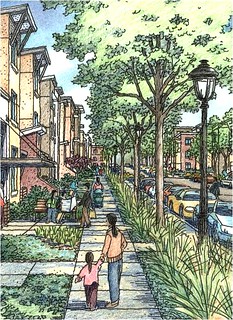 Applicants that qualify for a green rating (ranging from certified to platinum) may use the certifications to help gain approval and marketing advantage for their projects. 108 neighborhood-scale development projects, mostly (but not entirely) in the US and ranging from large to small and urban to suburban, have been certified under LEED-ND’s pilot program. Another 103 projects have registered for consideration under the fully approved formal system, launched two years ago; five of these, including two that feature affordable housing, have completed documentation and been certified.
Applicants that qualify for a green rating (ranging from certified to platinum) may use the certifications to help gain approval and marketing advantage for their projects. 108 neighborhood-scale development projects, mostly (but not entirely) in the US and ranging from large to small and urban to suburban, have been certified under LEED-ND’s pilot program. Another 103 projects have registered for consideration under the fully approved formal system, launched two years ago; five of these, including two that feature affordable housing, have completed documentation and been certified.
By intention, LEED-ND is a rigorous system that requires extensive documentation of green claims in credit categories pertaining to project location, design, and green management systems. The Affordable Green Neighborhoods grant program recognizes that smaller, often non-profit, developers working in distressed neighborhoods face special challenges in finding resources to cover registration fees and the costs of documentation. The program also recognizes that bringing green features to traditionally underserved populations is an important aspect of equitable sustainability.
This is the second round of funding that Bank of America has provided for the program. With the previous cycle, USGBC was able to provide assistance to ten affordable neighborhood redevelopment projects across the country. Each of the grant recipients’ projects featured the redevelopment and revitalization of a previously distressed neighborhood with badly outdated building stock, using a process centered on strong community involvement. In aggregate, the first-year grant recipient projects represent the creation of 4,741 rental and 1,681 for-sale homes all built to the highest standards of environmental sustainability and indoor air quality, with 84 percent and 48 percent reserved for low-income residents respectively.
Example: Sunnydale, certified gold
For example, San Francisco’s Sunnydale development, sponsored by Mercy Housing, has received gold certification under LEED-ND for an outstanding master plan to rebuild a 1940s-era public housing site -- the city’s largest -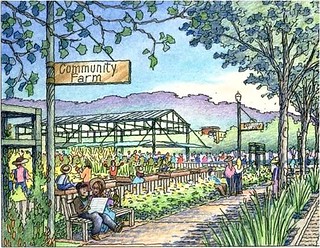 - with a mixed-income, mixed-amenity, green lifestyle community. The new, 50-acre development will be packed with great features (see renderings):
- with a mixed-income, mixed-amenity, green lifestyle community. The new, 50-acre development will be packed with great features (see renderings):
- 1,700 new public housing replacement homes, with affordable rental apartments and affordable and market rate for-sale homes
- A new “Life Center” with facilities for early childhood education, arts and enrichment programs, and a fitness facility available to the entire neighborhood
- 6.4 acres of new parks and playgrounds, a community garden and a farmer’s market
- 15,000 square feet of neighborhood-serving retail including a corner grocery, financial services, and healthy eating establishments
- 15,000 square feet of space for community services for seniors and job training for youth and adults
If approved by the city as proposed, the project also will include green streets to filter stormwater, excellent walkability and transit access, an internal neighborhood green, and access to an adjacent public park.
Sunnydale is part of San Francisco’s HOPE SF Initiative to rebuild public housing in San Francisco into thriving communities, following these principles:
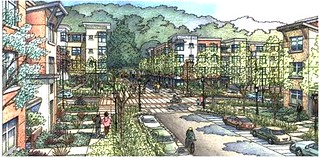 Ensure no loss of public housing
Ensure no loss of public housing- Create an economically integrated community
- Maximize the creation of new affordable housing
- Involve residents in the highest levels of participation
- Provide economic opportunities through the rebuilding process
- Integrate the development of the community with neighborhood plans to improve schools, parks and transportation
- Create environmentally sustainable and accessible communities
The sustainability principles embedded in LEED-ND can help projects get there, but Mercy Housing’s mission does not include budget for voluntary certifications. The grant program made the project’s participation possible.
Example: Village at Market Creek, certified silver
Another project whose participation in LEED-ND was made possible by the Affordable Green Neighborhoods Grant Program is The Village at Market Creek, a resident-led, -driven, and -owned development community in the Diamond Neighborhoods of southeastern San Diego. 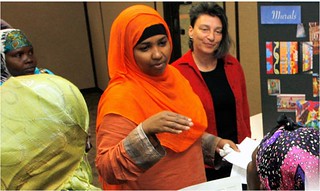 The Jacobs Center for Neighborhood Innovation has been working with a network of investors to transform approximately 60 acres of blighted, under-utilized properties on the Market Creek site into a highly walkable, transit-accessible community that is projected to create more than 1,000 jobs, 1,000 quality affordable housing units, 645,000 square feet of new commercial space, and at least 400,000 square feet of green open space and parks. (I last wrote about the development in this post about the federal Partnership for Sustainable Communities; an EPA brownfields grant helped them get started.)
The Jacobs Center for Neighborhood Innovation has been working with a network of investors to transform approximately 60 acres of blighted, under-utilized properties on the Market Creek site into a highly walkable, transit-accessible community that is projected to create more than 1,000 jobs, 1,000 quality affordable housing units, 645,000 square feet of new commercial space, and at least 400,000 square feet of green open space and parks. (I last wrote about the development in this post about the federal Partnership for Sustainable Communities; an EPA brownfields grant helped them get started.)
At the heart of the planning process, which has achieved Silver level certification under LEED-ND, is a “Cultural Village Plan” holistically focused on healthy living, supportive learning, compact design, walkability, transit-oriented development, equity, environmental sustainability, and resident ownership. Not limited to land use, the plan will be a physical, social, civic, and economic map of a healthy village that celebrates culture and promotes cross-cultural understanding in one of the most diverse communities in the nation.
Impressively, resident-led village planning teams are evolving goals, strategies, and outcomes for each of the project’s planning areas and building networks of non-profit organizations, public sector agencies, and philanthropic partners to support and implement the plan as the development is completed.
Applicants for the Affordable Green Neighbrhoods Grant Program will be notified of their status in mid-September, and winners will be announced in November. To learn more about the program and/or to apply, go here.
Related posts:
- The spectacular 'green way' to build affordable housing (October 13, 2011)
- Knowing when it's green: A Citizen's Guide to (LEED for) Neighborhood Development (May 25, 2011)
- Ten affordable neighborhoods-in-progress will design to LEED-ND standards under grant program (November 30, 2010)
- How LEED-ND works, step-by-step - evaluating a low-carbon development (August 24, 2010)
- Tassafaronga Village brings affordable gold and platinum to East Oakland (June 30, 2010)
- Habitat partners with state, private sector to build affordable LEED-ND project in Oakland (November 17, 2009)
Move your cursor over the images for credit information.
Please also visit NRDC’s sustainable communities video channel.
